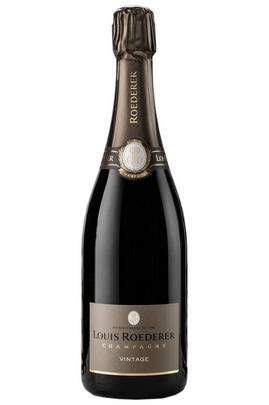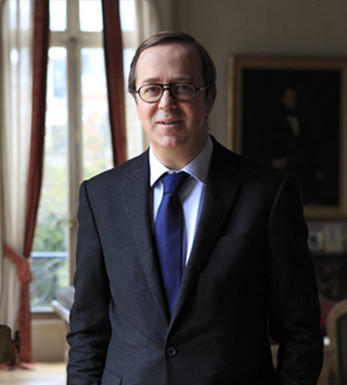
2014 Champagne Louis Roederer, Brut

Critics reviews
71% Pinot Noir, 29% Chardonnay with 25% vinified in oak tuns and 20% malolactic fermentation. RS 8 g/l.
There is real savour of age on the nose of this wine, which seems to have considerable development. Something very appetising on the palate but with the intrigue of the age on the nose. It may have 8 g/l dosage, but it tastes bone dry and extremely vibrant on the end. Only 20% malo presumably had an effect. Lots of wild-flower flavours – a bit of a wild card overall.
Drink 2019 - 2027
Jancis Robinson MW, JancisRobinson.com (October 2021)
Roederer's 2014 Brut Vintage is beautiful, offering up aromas of pear, mirabelle plum, red berries, warm biscuits and smoke. Full-bodied, layered and elegantly muscular, it's seamless and complete, with terrific mid-palate depth and amplitude. Framed by bright acids and enlivened by a pinpoint mousse, it concludes with a penetrating finish. The blend is 70% Pinot Noir, emphasizing Verzy, and pressure is a touch higher than in its more ethereal Blanc de Blancs counterpart. As I wrote of its 2013 predecessor, this is a wine that puts many prestige cuvées to shame.
Drink 2021 - 2045
William Kelley, Wine Advocate (September 2021)
Round and creamy, yet bright and tangy, with delicious pie crust, walnuts, lemons, sourdough, white peaches and apricot stones. More gourmand, with a creamy mousse. Lingering praline and pastry notes. Pinot noir and chardonnay.
Drink or hold
James Suckling, JamesSuckling.com (June 2022)
About this WINE

Louis Roederer
Founded in 1776, Louis Roederer is a family-owned, independent Champagne house with a well-deserved reputation for quality. It is managed by Frédéric Rouzaud, the seventh generation to be at the helm.
In 1876, Louis Roederer created the now-famous Cristal at the request of Alexander II. This once intensely sweet wine is now one of the most luscious, deeply flavoured champagnes available, with the '88, '89 and '90 among the greatest Cristals ever released.
Louis Roederer’s best-selling non-vintage blend for almost 40 years, Brut Premier, has recently been replaced by Collection 242. This new multi-vintage blend was created by Chef du Caves Jean-Baptiste Lécaillon in response to increasingly warm vintages. The cuvée aims to capture freshness and is based on a perpetual reserve which focuses on acidity and minerality.

Brut Champagne
Brut denotes a dry style of Champagne (less than 15 grams per litre). Most Champagne is non-vintage, produced from a blend from different years. The non-vintage blend is always based predominately on wines made from the current harvest, enriched with aged wines (their proportion and age varies by brand) from earlier harvests, which impart an additional level of complexity to the end wine. Champagnes from a single vintage are labelled with the year reference and with the description Millésimé.
Non-vintage Champagnes can improve with short-term ageing (typically two to three years), while vintages can develop over much longer periods (five to 30 years). The most exquisite and often top-priced expression of a house’s style is referred to as Prestige Cuvée. Famous examples include Louis Roederer's Cristal, Moët & Chandon's Dom Pérignon, and Pol Roger's Cuvée Sir Winston Churchill.
Recommended Producers : Krug, Billecart Salmon, Pol Roger, Bollinger, Salon, Gosset, Pierre Péters, Ruinart

Champagne blend
Which grapes are included in the blend, and their proportion, is one of the key factors determining the style of most Champagnes. Three grapes are used - Pinot Noir, Chardonnay and Pinot Meunier.
26% of vineyards in Champagne are planted with Chardonnay and it performs best on the Côtes des Blancs and on the chalk slopes south of Epernay. It is relatively simple to grow, although it buds early and thus is susceptible to spring frosts. It produces lighter, fresher wines than those from Burgundy and gives finesse, fruit and elegance to the final blend. It is the sole grape in Blancs de Blancs, which are some of the richest long-lived Champagnes produced.
Pinot Noir accounts for nearly 40% of the plantings in Champagne and lies at the heart of most blends - it gives Champagne its body, structure, strength and grip. It is planted across Champagne and particularly so in the southern Aube district.
The final component is Pinot Meunier and this constitutes nearly 35% of the plantings. Its durability and resistance to spring frosts make the Marne Valley, a notorious frost pocket, its natural home. It ripens well in poor years and produces a soft, fruity style of wine that is ideal for blending with the more assertive flavours of Pinot Noir. Producers allege that Pinot Meunier lacks ageing potential, but this does not deter Krug from including around 15% of it in their final blends.


Buying options
Add to wishlist
Description
71% Pinot Noir, 29% Chardonnay with 25% vinified in oak tuns and 20% malolactic fermentation. RS 8 g/l.
There is real savour of age on the nose of this wine, which seems to have considerable development. Something very appetising on the palate but with the intrigue of the age on the nose. It may have 8 g/l dosage, but it tastes bone dry and extremely vibrant on the end. Only 20% malo presumably had an effect. Lots of wild-flower flavours – a bit of a wild card overall.
Drink 2019 - 2027
Jancis Robinson MW, JancisRobinson.com (October 2021)
wine at a glance
Delivery and quality guarantee